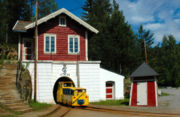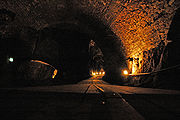
Kongsberg Silver Mines
Encyclopedia



Kongsberg
is a town and municipality in Buskerud county, Norway. It is located at the southern end of the traditional region of Numedal. The administrative centre of the municipality is the town of Kongsberg....
, in Buskerud
Buskerud
is a county in Norway, bordering Akershus, Oslo, Oppland, Sogn og Fjordane, Hordaland, Telemark, and Vestfold. The county administration is located in Drammen.-Geography:...
county in Norway
Norway
Norway , officially the Kingdom of Norway, is a Nordic unitary constitutional monarchy whose territory comprises the western portion of the Scandinavian Peninsula, Jan Mayen, and the Arctic archipelago of Svalbard and Bouvet Island. Norway has a total area of and a population of about 4.9 million...
, constitute the largest mining field in Norway, with over 80 different mines
Mining
Mining is the extraction of valuable minerals or other geological materials from the earth, from an ore body, vein or seam. The term also includes the removal of soil. Materials recovered by mining include base metals, precious metals, iron, uranium, coal, diamonds, limestone, oil shale, rock...
.
It was the largest pre-industrial working place in Norway
Norway
Norway , officially the Kingdom of Norway, is a Nordic unitary constitutional monarchy whose territory comprises the western portion of the Scandinavian Peninsula, Jan Mayen, and the Arctic archipelago of Svalbard and Bouvet Island. Norway has a total area of and a population of about 4.9 million...
, with over 4,000 workers at its peak in the 1770s and supplied over 10% of the gross national product of the Danish-Norwegian union during its 335 year long history: over 450,000 man-years were expended in the production.
First discovery of silver
Silver was first discovered between the 1 July and 5 July 1623. The story says that two small children - Helga and Jacob - were out shepherding their cattle at the top of Gruveåsen hill. They had an ox with them which scraped on the side of the mountain. They could see something shining and glimmering, and they picked it up and took it home to their father. Recognizing it as silver and quite valuable, he melted it and brought it to the town of SkienSkien
' is a city and municipality in Telemark county, Norway. It is part of the traditional region of Grenland. The administrative centre of the municipality is the city of Skien. Skien is also the administrative centre of Telemark county....
in Telemark
Telemark
is a county in Norway, bordering Vestfold, Buskerud, Hordaland, Rogaland and Aust-Agder. The county administration is in Skien. Until 1919 the county was known as Bratsberg amt.-Location:...
county to sell it. In Skien he was arrested, the police finding it suspicious that someone would attempt to sell silver at such a low price.
Being convinced that he was a thief, he was given the choice between telling where he had found the silver, or being sentenced to hard labour. He chose to tell the authorities he had found the silver in Southern Sandsvær
Sandsvær
Sandsvær is a former municipality in Buskerud county, Norway.Historically, Sandsvær as a part of Sandsvær og Numedal fogderi had belonged to Akershus amt from 7 February 1685 In 1760 Sandsvær fogderi was moved administratively to Buskerud....
, which was the old name for Kongsberg. The king of Norway
Norway
Norway , officially the Kingdom of Norway, is a Nordic unitary constitutional monarchy whose territory comprises the western portion of the Scandinavian Peninsula, Jan Mayen, and the Arctic archipelago of Svalbard and Bouvet Island. Norway has a total area of and a population of about 4.9 million...
and Denmark
Denmark
Denmark is a Scandinavian country in Northern Europe. The countries of Denmark and Greenland, as well as the Faroe Islands, constitute the Kingdom of Denmark . It is the southernmost of the Nordic countries, southwest of Sweden and south of Norway, and bordered to the south by Germany. Denmark...
at the time, Christian IV, came to Norway the following year and founded the town of Kongsberg
Kongsberg
is a town and municipality in Buskerud county, Norway. It is located at the southern end of the traditional region of Numedal. The administrative centre of the municipality is the town of Kongsberg....
in 1624.
Major tourist attraction
The silver mines are situated in Saggrenda, approximately 8 kilometres west of Kongsberg. Visitors to the King's Mine, the biggest mine in the Kongsberg area, board the mining train which takes them through the 2,300 metres of the Christian VII Adit. The bottom of the mine is 1,070 metres below the surface, which corresponds to 560 metres below sea level. Since its closure in 1958, the silver mines has been a preserved area. It's now open for guided tours for tourists, of whom some 40,000 every year enter the Kings Mine, which is the oldest, deepest, and richest mine in Kongsberg. On the tour, you can see the first man engineMan engine
A man engine is a mechanism of reciprocating ladders and stationary platforms installed in mines to assist the miners’ journeys to and from the working levels...
in Kongsberg in action. You can also see an impressive three-dimensional map of all the mines, a stope blown out with dynamite and the adits excavated by fire setting.
For a more physically demanding trip, tours are arranged from the Kings Mine through the Lower Mountain down to Kongsberg city, a trip of roughly five hours.
Arranging parties
The Banquet Hall of the King's Mine is also located here, billed as "The Most Unique Function Room in the Country". Originally intended as an emergency storage space for the Norwegian National Archives, the room now known as the Banquet Hall was constructed in 1943 and held 2,000 shelf-metres of documents and books.Now a banquet hall, this impressive room is a venue for concerts and plays as well as for banquets seating up to 200 people surrounded by solid rock and seated either side of long tables - just like in the mining days. The Banquet Hall is heated and has a modern, well equipped kitchen and toilet facilities.
The town of Kongsberg also houses the Norwegian Mining Museum, with an impressive display of silver, tools, and machinery utilised by the miners, engineers, and doctors.

